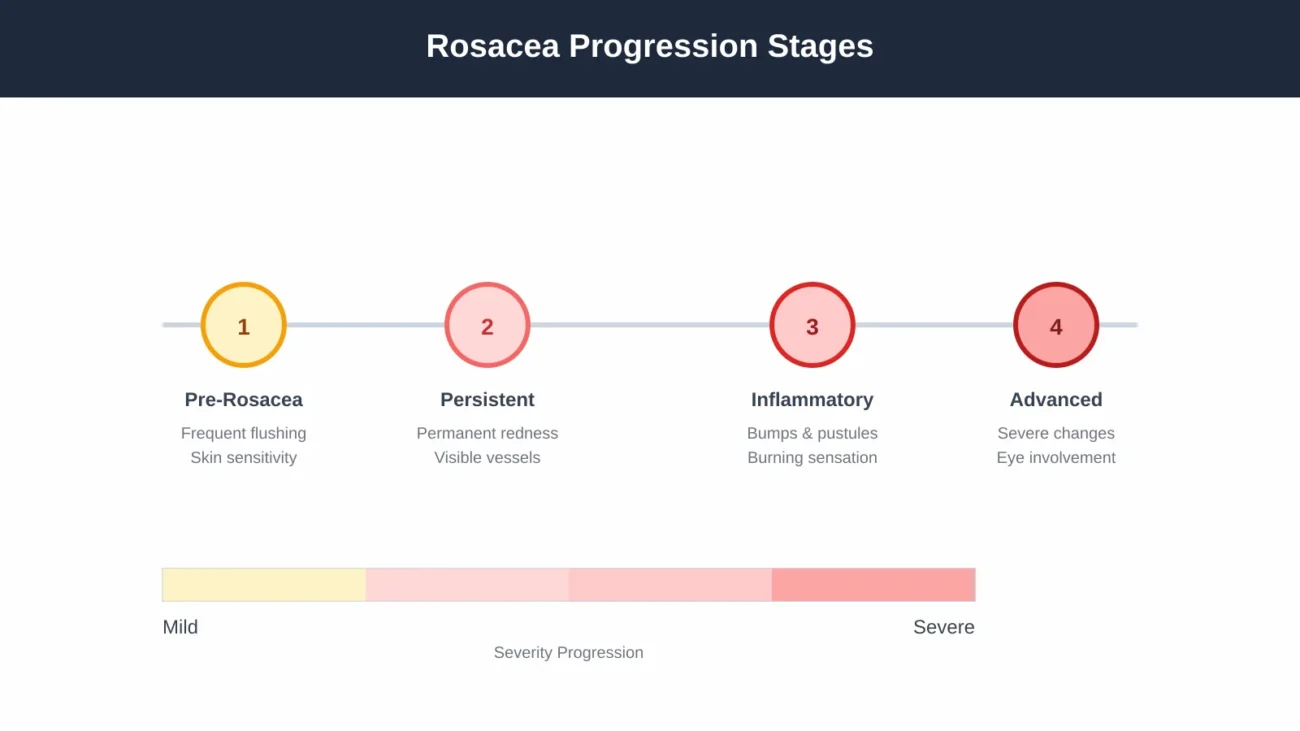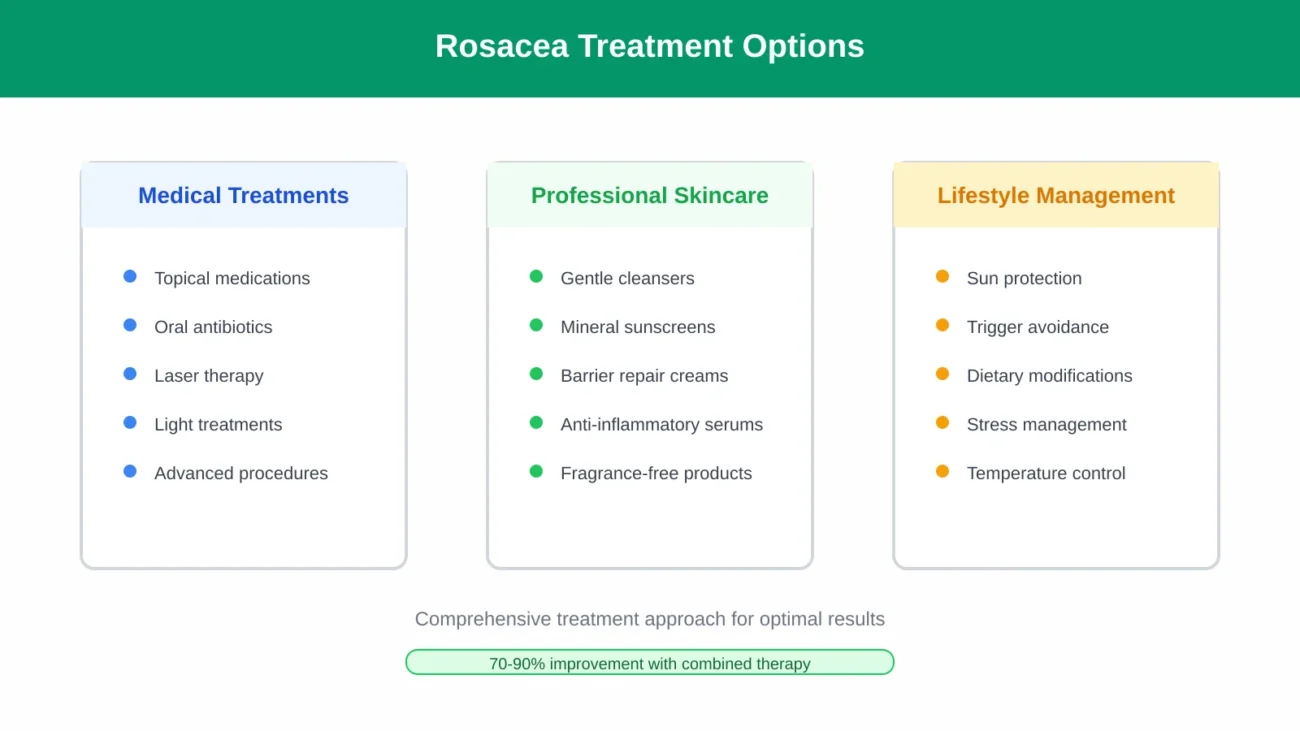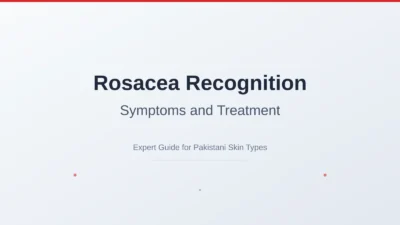Rosacea Recognition: Symptoms and Treatment for Skin Types
Rosacea affects millions worldwide, yet many people struggle to recognize its early symptoms or understand effective treatment options. This chronic inflammatory skin condition, characterized by persistent facial redness and visible blood vessels, requires proper medical attention to prevent progression and manage symptoms effectively.
Understanding rosacea’s unique presentation in Pakistani skin types and our climate conditions is crucial for early recognition and successful treatment. This comprehensive guide explores everything you need to know about identifying, treating, and managing rosacea for optimal skin health.
What is Rosacea?
Rosacea is a chronic inflammatory skin disorder that primarily affects the central face, including the cheeks, nose, chin, and forehead. Unlike temporary skin irritation, rosacea causes persistent redness that doesn’t fade with time. The condition typically develops in adults over 30 and tends to worsen without proper treatment.
The exact mechanism behind rosacea involves dysfunction of blood vessels, immune system abnormalities, and heightened sensitivity to environmental triggers.
Key characteristics of rosacea include:
- Persistent facial redness lasting more than three months
- Visible blood vessels (telangiectasia) on the face
- Inflammatory papules and pustules resembling acne
- Burning or stinging sensations in affected areas
- Eye involvement in some cases
What is the Main Cause of Rosacea?
The main cause of rosacea involves a complex interplay of genetic predisposition, immune system dysfunction, and environmental triggers. While no single factor causes rosacea, research identifies several primary contributors:
Genetic factors play a significant role, with family history increasing your likelihood of developing the condition. People of Celtic or Northern European descent traditionally showed higher rates, but dermatologists increasingly diagnose rosacea in Pakistani and South Asian populations.
Vascular abnormalities represent another major cause. Blood vessels in rosacea patients dilate more easily and remain dilated longer than normal, creating persistent redness. The neurovascular system becomes hypersensitive, responding excessively to triggers that wouldn’t affect healthy skin.
Immune system dysfunction contributes significantly to rosacea development. Patients with rosacea show elevated levels of inflammatory mediators and abnormal immune responses to normal skin bacteria, particularly Demodex folliculorum mites.
Environmental triggers act as catalysts rather than direct causes. Pakistani climate conditions, including intense UV radiation, high temperatures, and humidity fluctuations, can trigger and worsen rosacea symptoms in genetically susceptible individuals.
Hormonal changes often influence rosacea severity, particularly in women during menopause or pregnancy. Hormonal fluctuations can increase vascular sensitivity and inflammatory responses.
Recognizing Rosacea Symptoms:
Early recognition of rosacea symptoms enables prompt treatment and prevents progression to more severe stages. Rosacea typically develops gradually, with symptoms appearing in different combinations and intensities.
Stage 1: Pre-Rosacea
The earliest signs of rosacea often go unnoticed or are attributed to sensitive skin. Patients experience frequent flushing episodes that last longer than normal blushing. The face may feel hot, tight, or sensitive, particularly after sun exposure or consuming spicy foods.
Early warning signs include:
- Prolonged facial flushing lasting 10+ minutes
- Burning or stinging sensations without visible irritation
- Increased skin sensitivity to cosmetics or skincare products
- Persistent warmth in facial areas
Stage 2: Persistent Rosacea
As rosacea progresses, temporary flushing becomes permanent redness. Blood vessels become visible through the skin, creating a network of fine red lines across the cheeks and nose. Pakistani patients may notice these changes more prominently due to contrast with naturally darker skin tones.
Persistent symptoms include:
- Continuous facial redness that doesn’t fade
- Visible spider veins or broken capillaries
- Dry, rough skin texture in affected areas
- Increased sensitivity to temperature changes
Stage 3: Inflammatory Rosacea
This stage introduces acne-like bumps and pustules, leading many patients to mistake rosacea for adult acne. However, rosacea lacks the blackheads (comedones) characteristic of true acne. The inflammatory response intensifies, causing more discomfort and visible changes.
Inflammatory features include:
- Red bumps (papules) that may contain pus
- Burning or stinging sensations that worsen
- Swelling in affected areas
- Increased skin thickness and texture changes
Stage 4: Advanced Rosacea
Without treatment, some patients develop severe complications including rhinophyma (enlarged, bulbous nose) and ocular involvement. These advanced stages require aggressive medical intervention and may cause permanent changes.

What is the Biggest Trigger of Rosacea?
Sun exposure represents the biggest and most common trigger for rosacea flare-ups, affecting approximately 81% of patients according to dermatological studies. For Pakistani patients, this creates particular challenges given our intense UV radiation levels throughout the year.
Sun-related triggers include:
- Direct sunlight exposure, even for brief periods
- UV reflection from water, sand, or concrete surfaces
- Heat from sun exposure causing vasodilation
- Cumulative UV damage over time
Other major triggers affecting Pakistani patients:
Spicy foods rank as the second most common trigger, posing challenges for those who enjoy traditional Pakistani cuisine. Capsaicin in chili peppers, garam masala, and other spices can trigger immediate flushing and worsen existing rosacea.
Hot beverages including traditional chai, coffee, and hot water can trigger vasodilation and flushing. The temperature rather than caffeine content typically causes the reaction.
Temperature extremes common in Pakistani climate, from intense summer heat to air-conditioned environments, can trigger symptoms through rapid temperature changes.
Stress and emotions significantly impact rosacea severity. Work pressure, family stress, or anxiety can trigger flare-ups through hormonal and inflammatory pathways.
Skincare products containing alcohol, fragrances, or harsh chemicals can irritate sensitive rosacea skin. Many traditional remedies or home treatments can worsen the condition.
What is the Best Treatment for Rosacea?
The best treatment for rosacea involves a comprehensive approach combining medical therapies, lifestyle modifications, and consistent skincare routines tailored to individual triggers and severity levels.
Medical Treatments:
Topical medications form the foundation of rosacea treatment. Prescription options available in Pakistan include metronidazole gel, azelaic acid cream, and brimonidine gel for reducing redness. These medications require consistent application and typically show results after 4-6 weeks of use.
Oral antibiotics help control inflammatory components of rosacea. Doxycycline and minocycline remain first-line treatments, with low-dose formulations specifically designed for rosacea’s anti-inflammatory effects rather than antimicrobial action.
Laser and light therapies offer excellent results for reducing visible blood vessels and persistent redness. IPL (Intense Pulsed Light) treatments available in major Pakistani cities can significantly improve skin appearance with minimal downtime.
Advanced treatments including fractional laser resurfacing and radiofrequency treatments address texture changes and severe symptoms in specialized dermatology centers.

Professional Skincare Protocols:
Dermatologist-supervised skincare routines provide essential support for medical treatments. Gentle cleansing with pH-balanced, fragrance-free products helps maintain skin barrier function without triggering inflammation.
Recommended skincare approach:
- Gentle cream cleansers without sulfates or alcohol
- Mineral sunscreens with zinc oxide or titanium dioxide
- Fragrance-free moisturizers with ceramides or niacinamide
- Avoiding harsh scrubs, toners, or astringents
Trigger Management Strategies:
Effective rosacea management requires identifying and avoiding personal triggers through systematic elimination and reintroduction protocols. Keeping a detailed diary helps establish patterns between activities, foods, products, and flare-ups.
Practical trigger management:
- Daily broad-spectrum sunscreen application (SPF 30+)
- Wide-brimmed hats and protective clothing outdoors
- Gradual temperature changes when moving between environments
- Stress reduction techniques including meditation or exercise
- Dietary modifications reducing spicy foods and alcohol
How Can I Stop Rosacea?
While rosacea cannot be completely “stopped” or cured, effective management can achieve long-term remission and prevent progression. Success requires consistent medical treatment, lifestyle modifications, and ongoing professional supervision.
Comprehensive Management Strategy:
Immediate symptom control focuses on reducing active inflammation and preventing further irritation. This involves starting appropriate medical treatments while eliminating known triggers and establishing protective routines.
Long-term maintenance emphasizes preventing flare-ups through consistent skincare, trigger avoidance, and regular dermatological monitoring. Many patients achieve excellent control with this approach.
Progressive treatment adjustment allows for therapy modifications based on response and changing circumstances. Seasonal adjustments may be necessary given Pakistan’s climate variations.
Lifestyle Modifications for Prevention:
Sun protection remains the most critical preventive measure. Using broad-spectrum sunscreen daily, seeking shade during peak hours (10 AM – 4 PM), and wearing protective clothing significantly reduces flare-ups.
Dietary adjustments help many patients achieve better control. Gradually reducing spicy foods, identifying individual food triggers, and maintaining adequate hydration support overall management.
Stress management techniques including regular exercise, adequate sleep, and relaxation practices can reduce the frequency and severity of stress-induced flares.
Gentle skincare habits prevent irritation-induced flares. This includes using lukewarm water for cleansing, patting skin dry instead of rubbing, and applying products with gentle, upward motions.
Treatment Outcomes and Expectations:
Most patients with rosacea achieve significant improvement with appropriate treatment, though results require patience and consistency. Initial improvements typically appear after 4-8 weeks of treatment, with optimal results developing over 3-6 months.
Expected improvements include:
- 50-80% reduction in background redness
- Decreased frequency and intensity of flare-ups
- Improved skin texture and reduced sensitivity
- Better tolerance for previously triggering activities
Realistic timelines:
- Week 2-4: Reduced burning and stinging sensations
- Week 4-8: Visible reduction in redness and inflammation
- Month 3-6: Significant overall improvement and stabilization
- Ongoing: Maintenance therapy prevents progression
When to consult a dermatologist:
- Persistent facial redness lasting over 3 months
- Acne-like bumps that don’t respond to over-the-counter treatments
- Eye involvement including dryness, irritation, or vision changes
- Psychological impact affecting quality of life
- Uncertainty about diagnosis or treatment effectiveness
Conclusion:
Rosacea recognition and treatment success depends on understanding the condition’s complexity and committing to comprehensive management. While the main causes involve genetic predisposition and vascular dysfunction, the biggest triggers include sun exposure and spicy foods common in Pakistani culture.
The best treatments combine medical therapies with lifestyle modifications, while stopping rosacea progression requires consistent professional care and trigger avoidance. With proper management, most patients achieve excellent long-term control and significant quality of life improvements.
Early recognition and prompt professional treatment prevent progression and minimize long-term complications. Don’t let embarrassment or misconceptions delay appropriate care – effective treatments are available and can restore your confidence and comfort.

